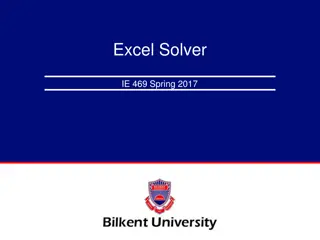Fast and Efficient MPM Solver for Strain Localization Problems
This study presents a fast and efficient Material Point Method (MPM) solver for strain localization problems, introducing the Generalized Interpolation Material Point Method (GIMPM) and Convected Particle Domain Interpolation (CPDI). The MPM computational phase involves mapping, nodal solution, and projection, utilizing advanced MPM variants to address cell-crossing errors and stress oscillations. The implementation in MATLAB includes explicit GIMPM/CPDI2q dynamic solver and implicit sMPM/CPDI2q quasi-static solver, demonstrating computational efficiency through benchmark tests.
Download Presentation

Please find below an Image/Link to download the presentation.
The content on the website is provided AS IS for your information and personal use only. It may not be sold, licensed, or shared on other websites without obtaining consent from the author. Download presentation by click this link. If you encounter any issues during the download, it is possible that the publisher has removed the file from their server.
E N D
Presentation Transcript
Fast and efficient MPM solver for strain Fast and efficient MPM solver for strain localization problems localization problems Antoine Guerin, Emmanuel Wyser, Yury Podladchikov, Michel Jaboyedoff
Outlines Outlines 1. General introduction a. The Material Point Method and its latest advancements (GIMPM and CPDI/CPDI2q) 2. Methods a. Numerical implementation & computational efficiency with MATLAB 3. Results 4. Perspectives
Overview of the Material Point Method (I) Overview of the Material Point Method (I) MPM (Sulsky etal, 1994) can be regarded as a FEM in which integration points (e.g., material points) are allowed to move (Guilkey etal, 2003). A computational phase is given by: 1. Mapping phase (A.) 2. Nodal solution (B.) 3. Projection of nodal solution to the material points (C.) The background mesh is reset at every steps Avoids excessive mesh distortions We select the Generalized Interpolation Material Point Method (GIMPM, Bardenhagen etal, 2004) and the Convected Particle Domain Interpolation (CPDI, Sadeghirad etal, 2013) variants
Overview of the Material Point Method (II) Overview of the Material Point Method (II) Figure 1: material point to element p2e connectivity array for a) standard MPM, b) GIMPM and c) CPDI2q. Whereas for sMPM and GIMPM the connectivity list is based on the material point s coordinates, the CPDI2q uses the material point s corners. Associated nodes of a material point are denoted by filled blue squares. The remaining nodes are said inactive with respect to the material point
Overview of the Material Point Method (III) Overview of the Material Point Method (III) The sMPM variant suffers from the cell-crossing error, i.e., once a material point enters a new element, the sharp discontinuity of the gradient of the shape function introduces stress oscillations in internal force vector. The GIMPM/CPDI2q partially cure this problem by using either extended shape functions that overlap neihboring elements (GIMPM) or interpolate shape functions at the corner s locations of material point s domain (quadrilateral domains in CPDI2q) Using this advanced MPM variants allows to overcome the large stress oscillations of sMPM (e.g., better solution of the pressure field) sMPM is well-adapted to problems in which material points do not cross their enclosing element
Numerical implementation in MATLAB (I) Numerical implementation in MATLAB (I) We implemented , in MATLAB, a. an explicit GIMPM/CPDI2q dynamic solver with a MUSL scheme and, b. an implicit sMPM/CPDI2q quasi-static solver. We first demonstrate the computational efficiency of both formulations (explicit / implicit) throughout a benchmark based on a classical case amongst the MPM community: the vertical elastic compression of a one element wide column subject to its self weigt (Coombs etal, 2020) We further compare both formulation to the case study of an elastoplastic domain under pure shear loading (Duretz etal, 2018)
Numerical implementation in MATLAB (II) Numerical implementation in MATLAB (II) Linear elastic stress-strain constitutive relation under the small strain theory is considered in this work. In addition, Jaumann stress-rate is implemented to ensure objectivity of the stress measure when large rotation effect cannot be neglected, i .e., ?J= ? ? Where ? is the isotropic elastic matrix and ?J is the Jaumann stress rate defined as (Bathe, 1996): ?J= ? + ? ? + ??
Numerical implementation in MATLAB (III) Numerical implementation in MATLAB (III) Plastic deformation is modeled with a Mohr-Couloumb law (Simpson, 2017), unlike Duretz etal (2018) who selected a Drucker-Prager model. The yield function is given by ? = ? + ? sin? ? cos? Where 2+ ??? ? =1 1 4??? ??? 2 2???+ ??? and ? =
Numerical implementation in MATLAB (IV) Numerical implementation in MATLAB (IV) The simple algorithm to return stresses to the yield surface read: ???= ? +1 ??? ???? 2 ???= ? 1 2??? ???? ???= ???? Where ?cos? ? sin? ? ? =
Numerical implementation in MATLAB (V) Numerical implementation in MATLAB (V) Gravitational loading is linearly increased up to g Explicit solver a. The total loading time should be greater than approx. 40 elastic wave transit times to reach quasi-static solution (Bardenhagen, 2004) considerable amount of iterations are required Implicit solver a. The gravitational loading is increased over 25 equal loadstep b. The admissible error for Newton s iterations is e of the out-of-balance force is 10 9 Figure 2: Model configuration and parameters used compression. Roller conditions are enforced on the boundaries of the domain. 4 material points per element are considered for the elastic
Numerical implementation in MATLAB (VI) Numerical implementation in MATLAB (VI) The convergence of implicit CPDI2q solver and explicit CPDI2q solver and the normalized error toward the analytical solution of the vertical Cauchy stress ??? is given by (Coombs etal, 2020) ?? ???? ???(??) ?? 0?0 ?0 ? error = ?=1 Where ???? is the vertical stress of a material p of an initial volume ?0 ?and initial vertical position ?0 amongst?? material points, ????? = ?? 0 ?0, and the volume of the column ?0
Numerical implementation in MATLAB (VII) Numerical implementation in MATLAB (VII) Figure configuration and model parameters used for the pure shear loading. Pure shear conditions are enforced normal to the boundary while the component is free (free- slip). This shearbands to reflect at the boundaries of the domain. 3: Model boundary tangential allows
Results (I) Results (I) Linear and quasi-quadratic convergence (implicit CPDI2q) Error saturation at 10 6 (explicit CPDI2q), e.g., could not resolve quasi-static solution (explicit integration and dynamic formulation, as mentioned by Bardenhagen etal, 2004) Consistent computational gain between quasi-static and dynamic solver Figure 4: (A) Respective runtimes of different solution with an increasing number of element and the run time of the MATLAB implementation AMPLE (GIMPM variant is utilized by Coombs etal, 2020) and, (B) the normalized error with respect to the analytical solution of the vertical Cauchy stress
Results (II) Results (II) From this validation test phase, we report the following: 1. The CPDI2q implicit solver implemented in MATLAB is fast, an order of magnitude for a high number of elements (1/h>50) 2. It is also efficient, delivering convergent results (for the quasi-static implicit formulation) for the elastic compression test. 3. The CPDI2q explicit solver suffers from error saturation and a large number of iterations to resolve quasi-static equilibrium 4. Its efficiency is therefore relative to the nature of the problem. We performed additional benchmarks (dynamic case such as the collision of two elastic disks) and observe a significant speed-up when compared to an actual solver written in a Julia language (Sinaie etal, 2017), at least 20 times faster and at worst 3-4 times faster.
Results (III) Results (III) Explicit (non-converged) solutions of the pure shear proposed in Duretz etal. (2018) Differences the two formulation are noticed (pressure field and magnitude of the second invariant of the plastic strain Localization is delayed (twice for the explicit solver) between two solutions Localization diffuse for the implicit solver (non-converged solution) compared to the explicit solution and implicit problem between the is more Figure 5a: explicit solution of the pure shear problem. The run time is approx 1216 s. Figure 5b: implicit (non-converged) solution of the pure shear problem. The run time is approx. 109 s.
Results (IV) Results (IV) Figure 6: Implicit solution (non-converged) for 50x25, 100x50 and 200x100 elements. The run time is respectively 109 s, 495 s and 1356 s.
Results (V) Results (V) The shearbanding behaviour obtained by the sMPM implicit solver is close to what was reported by Duretz etal (2018), i.e., Shearbands are orienting approx. 35 away from the compressive stress They are reflecting on the boundaries due to the tangential free-slip conditions A pressure drop progressively develops within the shearbands Non-convergent solutions are accepted since a huge amount of iterations would be needed to resolve equilibrium Both explicit and implicit solvers result in similar pressure fields and plastic deformations, but The explicit solver requires a dramatically high number of iteration, a sufficiently small time step and really tiny incremental displacement (ad minima a hundred times smaller than for the implicit solver) per time step to resolve proper shearbands However, we report a delay regarding the amount of incremental displacement applied on the boundaries to trigger strain localizations Such delay is even greater for the explicit solver
Perspectives and concluding remarks Perspectives and concluding remarks Both implicit and explicit formulation of MPM can model the pure shear problem described in Duretz etal (2018) The return mapping algorithm proposed by Simpson (2017) is able to correctly achieve the orientation of shearbands (when accepting non-converged solutions), but a consistent tangent operator for the implicit formulation would certainly help to achieve quadratic rate of convergence and therefore, an converged solution within a decent amount of time Further investigations are needed to understand i) the triggering delay between explicit and implicit formulation and, ii) the delay of the yielding onset with the results of Duretz etal (2018) Explicit formulation is able to resolve shearbanding, but at the expense of a huge amount of iteration An explicit implementation under C CUDA is the way forward to dispose of an efficient explicit solver
References References D. Sulsky, Z. Chen, and H. L. Schreyer, Computer Methods in Applied Mechanics and Engineering 118, 179 (1994). J. E. Guilkey and J. A. Weiss, International Journal for Numerical Methods in Engineering (2003). S. G. Bardenhagen and E. M. Kober, Computer Modeling in Engineering and Science 5, 447 (2004). G. Simpson, Practical Finite Element Modelling in Earth Science using MatLab (Wiley, 2017). Duretz, T., Souche, A., de Borst, R., Le Pourhiet, L., Geochemistry, Geophysics, Geosystem (2018) W. M. Coombs, C. E. Augarde, A. J., Advance in Engineering Software (2020) K. J. Bathe, Finite element procedures (New Jersey: Prentice Hall, 1996) A. Sadeghirad, R. M. Brannon, and J. E. Guilkey, Internation Journal for Numerical Methods in Engineering (2013) S. Sinaie, V. P. Nguyen, C. T. Nguyen, S. Bordas. Advances in Engineering Software (2017)























